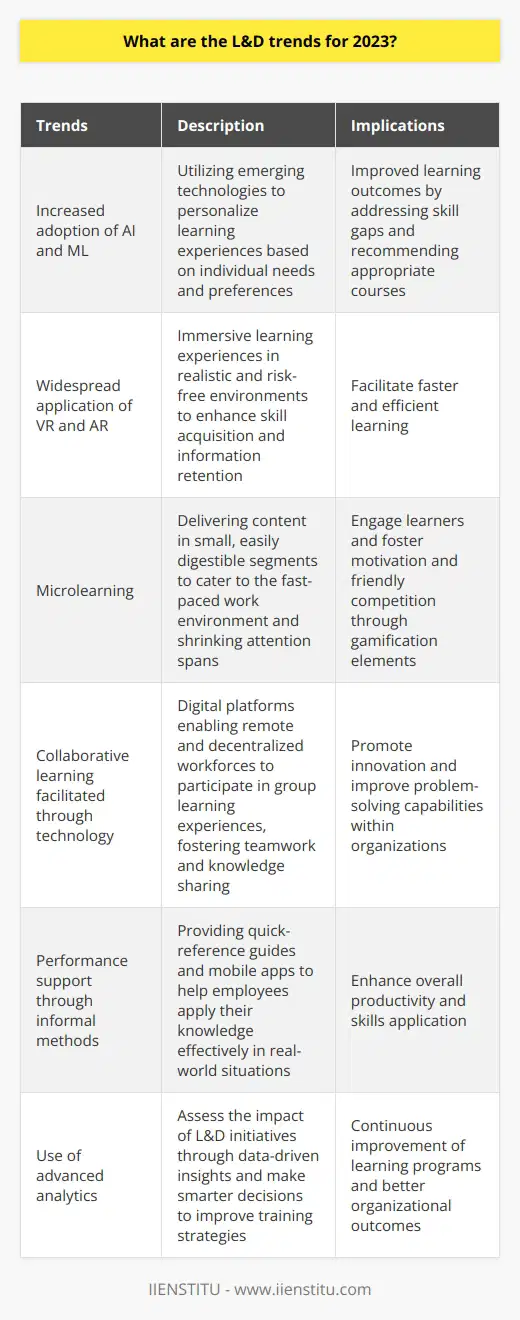
Introduction
Benefits of Training & Development
Strategies for Training & Development
Tips for Creating a Successful Training & Development Plan
Conclusion
Introduction
Training and development are essential parts of any business's success. It allows companies to ensure that their employees are adequately equipped with the skills, knowledge, and attitudes to be successful in their roles. This can increase productivity, motivate employees, and improve customer service. Training and development can also help businesses reduce costs, enhance employee development and increase the flexibility of their workforce.
Benefits of Training & Development
The benefits of training and development are numerous. Firstly, it helps businesses stay competitive. Companies can stay ahead of the competition by ensuring that employees are kept up to date with the latest tools, skills, and software. Secondly, training and development can motivate employees and help them feel valued. This will result in greater job satisfaction and lower employee turnover.
Another benefit of training and development is that it can help businesses identify and develop talented employees. By providing opportunities for employees to develop their skills, companies can identify talented individuals and ensure they remain integral to the business's success.
Strategies for Training & Development
Regarding training and development, there are several strategies businesses can use. The most effective method is to tailor the training to the business's specific needs. For example, a company may focus on developing a specific skill set in its employees or ensuring they can use particular software packages.
In addition to tailoring training to the needs of the business, businesses can also create a positive learning environment. This can include providing workshops, webinars, online courses, and seminars. This allows companies to provide targeted training for specific departments or roles, which can be conducted more efficiently and cost-effectively.
Tips for Creating a Successful Training & Development Plan
Businesses should consider the following tips when creating a training and development plan.
Firstly, it is essential to set realistic goals. Goals should be SMART (specific, measurable, achievable, relevant, and time-bound) to ensure the training is practical and relevant to the business's needs.
Secondly, businesses should ensure that their training and development plan is tailored to the needs of their employees. This will ensure that employees are engaged and motivated during the training process.
Thirdly, businesses should use various methods and techniques to provide training. This can include online courses, workshops, and seminars and providing mentors and coaches who can offer advice and guidance.
Finally, businesses should monitor and review their training and development plans regularly. This will ensure that the training meets and effectively implements the business's needs.
Conclusion
Training and development are an essential parts of any successful business. It helps companies to stay competitive, motivates employees, and allows them to develop their skills. By adopting effective strategies and creating a successful training and development plan, companies can ensure their employees have the skills and knowledge needed to succeed.
Investing in training and development is an investment in transforming your business.
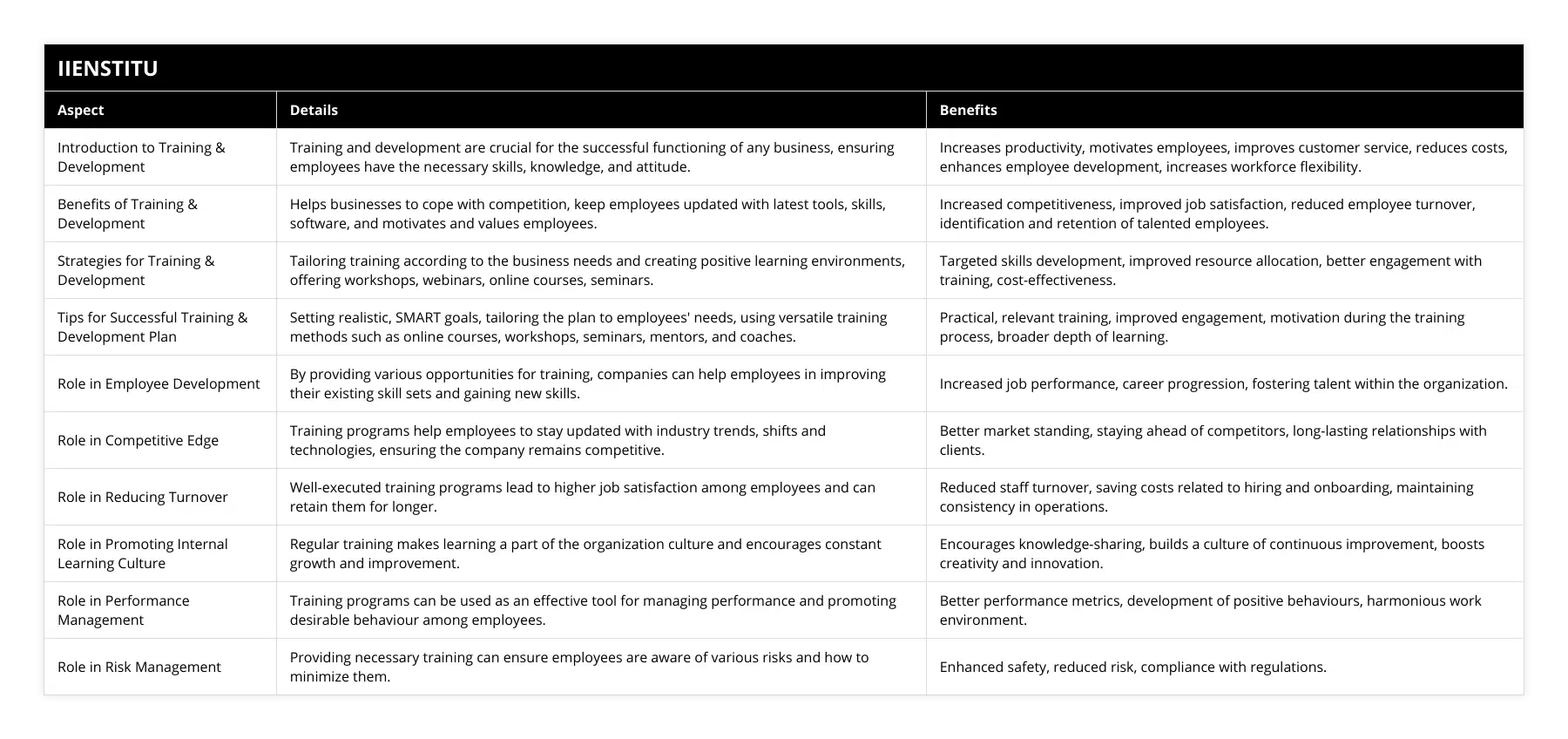
Frequently Asked Questions
What are the benefits of transforming one's business with training and development?
Businesses increasingly recognize the effectiveness of training and development in helping them achieve higher performance levels. Training and development are not just about helping employees acquire new skills but also about preparing them for the changing dynamics of the organization. By nurturing and growing their team's existing skills and knowledge through training and development, companies can maximize their potential, provide employees with greater confidence, increase their productivity, and, ultimately, develop a competitive edge.
Training and development's most important benefits are increased employee engagement and job satisfaction. With the proper training and development programs, employees feel empowered and gain a sense of accomplishment and control over their job. Plus, they are better equipped to handle the demands of their career and develop the skills necessary to fulfill their tasks. This leads to better team synergy and higher job satisfaction and loyalty, improving employee retention rates.
Furthermore, training and development can help organizations avoid costly mistakes, which can negatively affect a business's reputation. High-quality training and development programs introduce employees to best practices and policies that enable them to complete tasks more efficiently and with fewer errors. This, in turn, helps to ensure customer satisfaction and higher customer retention levels by providing a superior customer experience.
Introducing practical training and development can also enhance an organization's productivity through improved team performance. As well as equipping employees with new skills, it can develop and strengthen existing skill sets and make them more proficient in the tasks. This allows employees to work smarter, not harder, improving overall efficiency.
Finally, training and development can help organizations stay ahead of the competition. Businesses can reduce the risk of obsolescence by providing employees with the knowledge and skills required to remain productive and competitive. In addition, training and development can give a company the edge when introducing and implementing new trends or technologies, allowing it to stay ahead of the competition regarding innovation and customer service.
The benefits of incorporating training and development into an organization's business strategy can provide companies with a competitive edge regarding customer retention rate, employee retention, productivity, and innovation. In addition, training and development can help businesses develop their employees, allowing them to deliver superior customer experiences and maintain their competitive advantage.
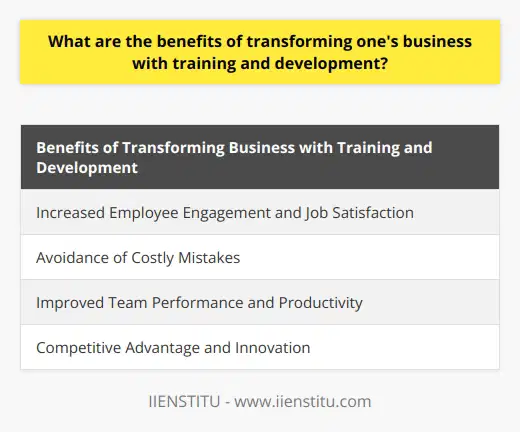
What types of training and development should be considered in the transformation?
Corporate training and development are essential to ensure a successful transformation. A consideration of the types of training and development can be instrumental in determining the shift's success. Depending on the extent of the change, organizations must consider several categories for training and development.
First, organizations should consider offering employees current knowledge and technical training to adapt to new technologies, policies, and procedures. Employees should be trained on the latest systems, processes, and tools; organizational leadership should also ensure that employees understand the company goals and objectives of the transformation. Technical skills such as software proficiency and IT security can be critical, as they may be necessary to perform salient tasks.
Organizations should also consider providing educational and instructional courses. Organizations may purchase courses or develop classes based on their needs. These educational and instructional courses may include communication, customer service, problem-solving, and conflict resolution. Such systems can be valuable for employees to have updated information about the transformation process and to understand the importance of the transformation for their organization.
Organizations should also consider providing personal development courses. These courses are designed to help employees develop the skills needed to cope with the changes associated with the transformation. For example, individual development courses may include team building, leadership development, stress management, and time management.
Finally, organizations should consider providing yearly assessments. This can offer the opportunity to review the extent of the transformation and measure the skills and abilities of the employees. Through assessments, organizations can identify employees' areas of strengths and weaknesses. This process can generate valuable data for future training and development efforts.
Organizations should consider all types of training and development to ensure a successful transformation. Each of these categories of training and development should be tailored to meet the organization's and its employees' specific needs. With careful evaluation and implementation of the appropriate training and development, organizations can succeed in their transformation efforts.

How will training and development help to ensure the success of a business transformation?
Successful business transformation requires a well-designed and comprehensive approach that includes both organizational and technological strategies that are mutually reinforced. Training and development play an essential role in these strategies, enabling employees to absorb the qualitative and quantitative changes that the transformation brings.
In particular, when the transformation involves a shift in the company's service orientation, training and development programs can help employees understand how to properly use the new services and apply them as effectively as possible. Moreover, these programs also enable employees to develop new skills and adapt to new business realities. Developing problem-solving, decision-making, and communication skills is necessary for successfully implementing the transformation process.
Furthermore, training and development activities are appropriate for teaching critical managerial and leadership skills and building the knowledge and experience necessary for effective business transformation management. These programs should be tailored to the needs of the company, taking into account the type of transformation, the culture of the company, and its operational context. The training and development activities should focus on developing the skills required to implement the transformation plan, such as strategic planning, change management, and motivation. In addition, the aim should be to ensure the technical proficiency of the staff and their communication and team collaboration skills.
In conclusion, training and development are essential factors that can help ensure a business transformation's success. A successful training and development program should consider not only the technical aspects of the change but also its cultural aspects, the development of managerial and leadership skills, and the development of team collaboration. Ultimately, success in this area will ensure that employees can better absorb the changes and acquire the necessary skills for successful business transformation.
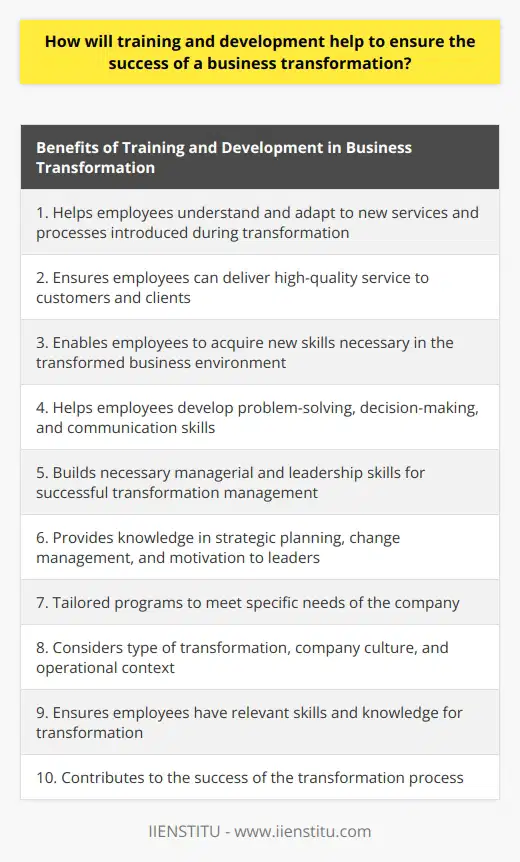
How could you link training and development to company strategy?
Linking Training and Development to Company Strategy
Aligning Objectives
To effectively link training and development (T&D) to company strategy, it is essential to align the T&D objectives with the company's overall goals. This ensures that employees receive the necessary skills and knowledge to contribute to the organization's long-term strategic objectives. By focusing on the key areas of the company strategy, T&D programs can directly target vital skills for organizational success, thereby enhancing workforce competence and productivity.
Customized Learning
Next, customize T&D programs according to the company's strategic focus, ensuring that specific skills and knowledge gaps are addressed. A customized approach to learning promotes employee engagement and effectiveness, as it offers tailored content relevant to their roles. To achieve this, training managers should collaborate with executive leadership, HR, and line managers to identify areas where improvement is required and design training programs accordingly.
Measuring Success
A strong indicator of the success of T&D in a company is having a robust evaluation system in place. This system should measure the effectiveness of training programs by assessing the extent to which training objectives have been met and how employees apply the acquired skills in their job functions. The evaluation process should be closely aligned with the organization's strategic objectives, enabling the company to monitor progress during and after the training process. The results of this evaluation can serve as valuable feedback for both the employees and the organization, helping them continuously improve and remain aligned with the company's strategic goals.
Human Capital Value
Moreover, human capital should be viewed as a valuable asset directly connected to the success of the organization's strategy. By investing in T&D, organizations can maintain a workforce prepared to embrace ongoing changes in the business landscape. Upskilling and reskilling employees is crucial for staying competitive, adapting to technological advancements, and managing shifts in customer demands. Emphasizing a strategic approach to T&D highlights the importance of human capital and the need for continuous investment in employees.
In conclusion, linking training and development to company strategy involves aligning T&D objectives with organizational goals, customizing learning programs, measuring success through robust evaluations, and recognizing the value of human capital in achieving strategic success. A well-structured and strategically aligned T&D program can significantly boost an organization's competitive advantage by fostering employee development and growth in line with the company's strategic objectives.
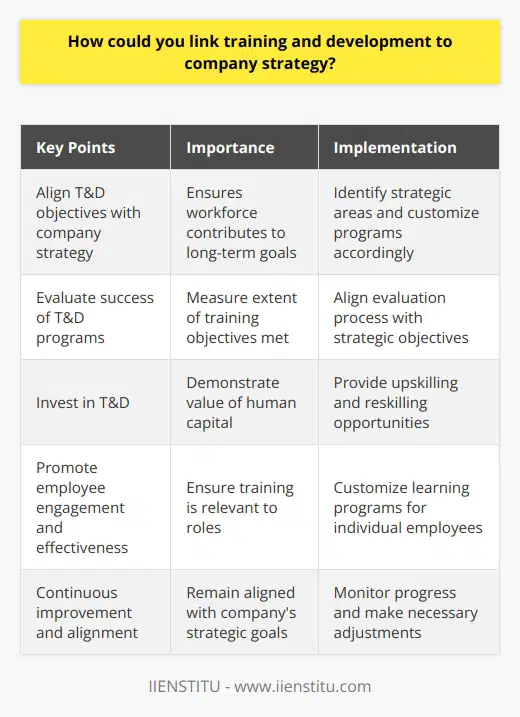
Why is training and development important for business success?
Importance of Training and Development
Enhancing Employee Skills
Training and development are essential for business success because they help to enhance employee skills, making them more competent and efficient in their roles. By investing in the growth of their workforce, companies empower their employees to be more productive and adaptable to changing business environments. This ultimately leads to increased output, better decision-making, and improved performance across the organization.
Boosting Employee Morale
Another reason training and development are important is because they positively impact employee morale and job satisfaction. Employees who receive adequate training and development opportunities feel more engaged, appreciated, and valued by their employers, resulting in higher retention rates and a more committed workforce. This, in turn, translates to better customer service and a stronger company reputation, both of which contribute to a more successful business.
Promoting Innovation
Training and development also play a critical role in promoting innovation within a company. As employees acquire new skills, they are more likely to develop creative solutions to problems and propose novel ideas that advance the organization's strategic objectives. By fostering a culture of continuous learning and experimentation, businesses can remain competitive and position themselves for lasting success in an increasingly dynamic global market.
Reducing Organizational Risk
A well-trained and developed workforce contributes to reducing various organizational risks. Training employees on workplace safety procedures, legal compliance, and business ethics decreases the likelihood of accidents, litigation, and other costly consequences that could negatively impact a company's bottom line and reputation. Thus, investing in workforce development can be seen as a necessary safeguard against potential liabilities, promoting long-term success and organizational stability.
Adapting to Change
Finally, training and development are vital to organizational success because they enable businesses to adapt more readily to change. In an ever-evolving marketplace, companies must be agile and responsive to shifting customer needs, technological advancements, and competitive pressures. By equipping employees with the skills and knowledge required to navigate these changes, businesses can improve their chances of survival and propel themselves towards continued growth and success.
In conclusion, training and development in a business context are crucial for enhancing employee skills, boosting morale, promoting innovation, reducing organizational risk, and adapting to change. By investing in the continuous growth and development of employees, companies lay the foundation for their own long-term success and sustainability in an increasingly competitive global market.
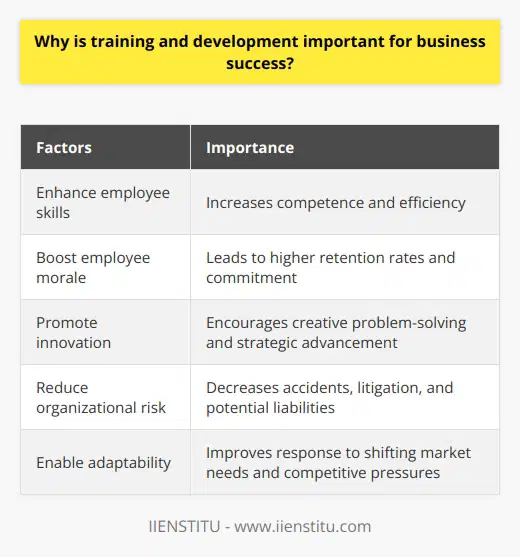
What are the L&D trends for 2023?
Emerging Technologies in L&D
In the landscape of learning and development (L&D), 2023 promises innovative trends such as the increased adoption of emerging technologies. For instance, artificial intelligence (AI) and machine learning (ML) will provide personalized learning experiences, tailored to individual learners' needs and preferences. These smart systems will help organizations identify skill gaps and recommend specific courses, leading to improved learning outcomes.
Virtual and Augmented Reality
Another trend expected in L&D for 2023 is the widespread application of virtual reality (VR) and augmented reality (AR) technologies. These immersive learning experiences will allow learners to practice skills in realistic, risk-free environments. This hands-on approach can enhance the retention of critical information and accelerate the acquisition of new skills.
Microlearning and Gamification
Microlearning, the practice of delivering content in small, easily digestible segments, will become more prevalent in 2023. By providing content in a concise, easily accessible format, microlearning caters to today's fast-paced work environment and shrinking attention spans. In addition, incorporating gamification elements, such as badges and leaderboards, will further engage learners, promoting motivation and friendly competition.
Collaborative Learning Opportunities
In response to the growing trend toward remote and decentralized workforces, 2023 will see a rise in collaborative learning opportunities facilitated through technology. Digital platforms will enable employees from diverse locations to engage in group learning experiences, fostering teamwork and knowledge sharing. This approach will lead to increased innovation and improved problem-solving capabilities within organizations.
Performance Support and Analytics
Effective learning strategies will increasingly focus on providing performance support for employees. Learning resources will shift from being solely course-oriented to offering informal support, such as quick-reference guides and mobile apps. This shift will help employees apply their knowledge more effectively in real-world situations, enhancing overall productivity.
Furthermore, the use of advanced analytics will enable organizations to assess the impact of their L&D initiatives better. Incorporating data-driven insights will allow for smarter decision-making and continuous improvement in training strategies.
Conclusion
In summary, the L&D trends for 2023 will revolve around incorporating emerging technologies, enhancing learning experiences with immersive solutions, and leveraging analytics and performance support. These advances will lead to more engaging, effective, and impactful learning opportunities for employees, paving the way for organizational growth and success.
